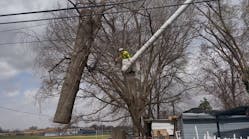Considering one of the goals I have for Vegetation Management Insights is to bridge the gap between the broader utility market, utility executives in particular and the VM group, it’s important that we establish a common language to ensure effective communication.
To that end, I’m going to introduce and discuss the terms vegetation management, line clearance, pruning, tree removal, hazard trees, danger trees, the utility forest and tree trimming.
First, let us dispense with the term tree trimming. If your tree work meets ANSI standards, as it ought, then you are pruning trees. Pruning involves the judicious removal of plant parts. That’s right, every branch or part of a branch that is cut requires judgments. That is because the placement of the cut influences the extent of sprouting: whether there will be sprouts, the number of sprouts and the rate of growth of those sprouts and whether future growth will be away from or toward the line. Secondly, tree trimming is sometimes intended to refer to only pruning operations and sometimes to all tree work. By dispensing with the term tree trimming we can avoid potential confusion - more on that later.
Line clearance is another term that has been used for utility vegetation management. While it doesn’t create as much confusion as the term tree trimming, because it places the focus on clearance, it too is ambiguous.
Vegetation management is a broad term that includes tree pruning; brush removal through the use of power saws and mowers; the judicious use of herbicides and tree growth regulators; hazard tree identification and removal; the implementation of strategies to minimize the establishment of incompatible species under and near power lines; and the control of weeds.
Hazard trees and danger trees are not the same thing. Hazard trees are a subset of danger trees. These terms are defined in ANSI standards (ANSI 300 Part 7). Accordingly, a danger tree is any tree on or off the right of way that could contact electric supply lines. A hazard tree is a structurally unsound tree that could strike electric supply lines when it fails. These definitions provide an important distinction for vegetation managers. First, the danger tree definition establishes that, from a utility perspective, even a healthy, apparently sound tree constitutes a risk to electric facilities. While the risk of failure of a tree may not be known, we know that all trees can fail given enough stress loading and consequently, the risk is not zero. Therefore, we need to conclude all danger trees are a liability. This liability becomes apparent during major storm events. By making a distinction between danger trees and hazard trees it also becomes apparent that even the most effective hazard tree removal program does not reduce the risk of tree-caused outages to zero. Further, it facilitates realistic thinking about the impact of the hazard tree program on reliability. Since hazard trees are subset of danger trees, it logically leads us to ask what percent of danger trees are hazard trees?
The utility forest consists of the land base supporting tree species that could now or in the future interfere with safe, reliable electric service. The concept is useful in guiding thinking about trees and their impact on reliability. The population of trees in natural forest stands is high when the trees are small but as they grow and compete for light, water and nutrients there are necessarily winners and losers. That is, there is ongoing tree mortality. The term utility forest helps to bring clarity in this regard. The removal of a solitary tree in a landscaped setting permanently removes the reliability risk associated with that tree exposure. However, for an electric line running alongside a natural tree stand, the removal of a hazard tree cannot be said to permanently reduce the reliability risk because natural tree mortality continues to produce a population of hazard trees.
I need to state that within the VM industry, some of this terminology is relatively new and consequently, it will take time for everyone to use the terms consistently. Not only will the use of consistent terminology increase the effectiveness of communication but I believe it will facilitate an understanding of conditions and actions that will yield reliability improvements.
In the aftermath of major storms, a question that inevitably arises is whether more tree trimming could have averted a meaningful amount of the storm damage. What is meant by tree trimming is not clear. In most cases, more frequent pruning will be at best a minimally effective mitigation strategy. That is because storm stress-induced, tree-caused service interruptions arise predominantly from the failure of large branches or whole trees. We could say a rigorous hazard tree removal program holds the potential to decrease storm damage. To what extent this is true will be left for a future discussion. At this time, I only wish to illustrate that failure to use a precise and common language leads to incorrect conclusions and in the context of seeking to improve reliability, a misallocation of resources.

